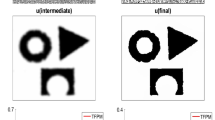Abstract
We propose an efficient multilayer segmentation method based on implicit curve evolution and on variational approach. The proposed formulation uses the minimal partition problem as formulated by D. Mumford and J. Shah, and can be seen as a more efficient extension of the segmentation models previously proposed in Chan and Vese (Scale-Space Theories in Computer Vision, Lecture Notes in Computer Science, Vol. 1682, pp. 141–151, 1999, IEEE Trans Image Process 10(2):266–277, 2001), and Vese and Chan (Int J Comput Vis 50(3):271–293, 2002). The set of unknown discontinuities is represented implicitly by several nested level lines of the same function, as inspired from prior work on island dynamics for epitaxial growth (Caflisch et al. in Appl Math Lett 12(4):13, 1999; Chen et al. in J Comput Phys 167:475, 2001). We present the Euler–Lagrange equations of the proposed minimizations together with theoretical results of energy decrease, existence of minimizers and approximations. We also discuss the choice of the curve regularization and conclude with several experimental results and comparisons for piecewise-constant segmentation of gray-level and color images.
Similar content being viewed by others
References
Aronsson G. (1967). Extension of functions satisfying Lipschitz conditions. Ark. Mat. 6(6): 551–561
Caflisch R.E., Gyure M.F., Merriman B., Osher S., Ratsch C., Vvedensky D.D. and Zinck J.J. (1999). Island dynamics and the level set method for epitaxial growth. Appl. Math. Lett. 12(4): 13
Caselles V., Morel J.-M. and Sbert C. (1998). An axiomatic approach to image interpolation. IEEE Trans. Image Process. 7(3): 376–386
Chan T.F., Sandberg B.Y. and Vese L.A. (2000). Active contours without edges for vector-valued images. J. Vis. Commun. Image Represent. 11(2): 130–141
Chan, T.F., Vese, L.: An active contour model without edges. In: Scale-Space Theories in Computer Vision, Lecture Notes in Computer Science, Vol. 1682, pp. 141–151 (1999)
Chan T.F. and Vese L.A. (2001). Active contours without edges. IEEE Trans. Image Process. 10(2): 266–277
Chen S., Kang M., Merriman B., Caflisch R.E., Ratsch C., Fedkiw R., Gyure M.F. and Osher S. (2001). Level set method for thin film epitaxial growth. J. Comput. Phys. 167: 475
Chung, G., Vese, L.A.: Energy minimization based segmentation and denoising using a multilayer level set approach. In: Rangarajan, A., Vemuri, B., Yuille, A.L. (eds.) Energy Minimization Methods in Computer Vision and Pattern Recognition, 5th International Workshop, EMMCVPR 2005, St Augustine, FL, USA, 9–11 November 2005. LNCS, Vol. 3757/2005, pp. 439–455 (2005)
Cohen L.D. (1997). Avoiding local minima for deformable curves in image analysis. In: Le Méhauté A., Rabut C., Schumaker L.L. (eds). Curves and Surfaces with Applications in CAGD, pp. 77–84
Cohen, L., Bardinet, E., Ayache, N.: Surface reconstruction using active contour models. In: Proceedings of SPIE 93 Conference on Geometric Methods in Computer Vision, San Diego (1993)
Dervieux A. and Thomasset F. (1979). A finite element method for the simulation of Rayleigh–Taylor instability. Lect. Notes Math. 771: 145–159
Dervieux A. and Thomasset F. (1980). Multifluid incompressible flows by a finite element method. Lect. Notes Phys. 141: 158–163
Evans L.C. and Gariepy R. (1992). Measure Theory and Fine Properties of Functions. CRC Press, London
Gyure M.F., Ratsch C., Merriman B., Caflisch R.E., Osher S., Zinck J.J. and Vvedensky D.D. (1998). Level set methods for the simulation of epitaxial phenomena. Phys. Rev. E 58: R6927
Jensen R. (1993). Uniqueness of Lipschitz extensions—minimizing the sup norm of the gradient. Arch. Ration. Mech. Anal. 123(1): 51–74
Kimmel R. (2003). Fast Edge Integration. In: Osher, S. and Paragios, N. (eds) Geometric Level Set Methods in Imaging, Vision and Graphics, pp 59–77. Springer, Heidelberg
Lie J., Lysaker M. and Tai X.-C. (2006). A Binary Level Set Model and Some Applications to Mumford-Shah Image Segmentation. IEEE Trans. Image Process. 15(5): 1171–1181
Mumford D. and Shah J. (1989). Optimal approximation by piecewise smooth functions and associated variational problems. Comm. Pure Appl. Math. 42: 577–685
Osher S. and Sethian J. (1988). Fronts propagating with curvature-dependent speed—algorithms based on Hamilton–Jacobi formulations. JCP 79(1): 12–49
Paragios N. and Deriche R. (1999). Unifying boundary and region-based information for geodesic active tracking. Proc. Comput. Vision Pattern Recognit. 2: 23–25
Paragios N. and Deriche R. (2002). Geodesic active regions: a new framework to deal with frame partition problems in computer vision. J. Vis. Commun. Image Represent. 13(1–2): 249–268
Paragios N. and Deriche R. (2002). Geodesic active regions and level set methods for supervised texture segmentation. IJCV 46(3): 223–247
Rudin L.I., Osher S. and Fatemi E. (1992). Nonlinear Total variation based noise removal algorithms. Phys. D Nonlinear Phenomena 60(1–4): 259–268
Samson, C., Blanc-Féraud, L., Aubert, G., Zérubia, J.: A Level Set Model for Image Classification. LNCS, vol. 1682, pp. 306–317
Samson C., Blanc-Féraud L., Aubert G. and Zérubia J. (2000). A level set model for image classification. IJCV 40(3): 187–197
Tsai A., Yezzi A. and Willsky A.S. (2001). Curve evolution implementation of the Mumford-Shah functional for image segmentation, denoising, interpolation, and magnification. IEEE Trans. Image Process. 10(8): 1169–1186
Vese L.A. and Chan T.F. (2002). A multiphase level set framework for image segmentation using the Mumford and Shah model. Int. J. Comput. Vis. 50(3): 271–293
Vese L. (2003). Multiphase Object Detection and Image Segmentation. In: Osher, S. and Paragios, N. (eds) Geometric Level Set Methods in Imaging, Vision and Graphics, pp 175–194. Springer, Heidelberg
Zhao H.-K., Chan T., Merriman B. and Osher S. (1996). Variational level set approach to multiphase motion. J. Comput. Phys. 127(1): 179–195
Author information
Authors and Affiliations
Corresponding author
Additional information
Communicated by K. Mikula.
Rights and permissions
About this article
Cite this article
Chung, G., Vese, L.A. Image segmentation using a multilayer level-set approach. Comput. Visual Sci. 12, 267–285 (2009). https://doi.org/10.1007/s00791-008-0113-1
Received:
Accepted:
Published:
Issue Date:
DOI: https://doi.org/10.1007/s00791-008-0113-1




